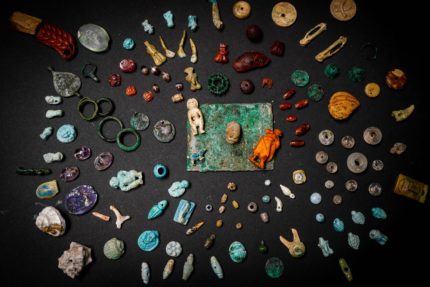A trove of amulets, figurines, jewels and decorative pieces made of Egyptian faience, bronze, bone, amber, amethyst, stone, glass and crystal has been 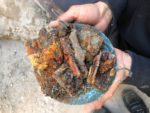 unearthed at Pompeii. The remains of wooden chest with bronze hinges were found in an excavation of the House of the Garden in Regio V, the same elegant villa where in 2018 a charcoal inscription indicating the eruption of Vesuvius took place on October 24th instead of the conventional August 24th date. The find site was not in the elegant part of the house, but rather in a corner of what is believed to have been a service area.
unearthed at Pompeii. The remains of wooden chest with bronze hinges were found in an excavation of the House of the Garden in Regio V, the same elegant villa where in 2018 a charcoal inscription indicating the eruption of Vesuvius took place on October 24th instead of the conventional August 24th date. The find site was not in the elegant part of the house, but rather in a corner of what is believed to have been a service area.
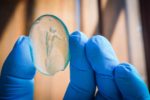 Traces of the wood and the imprint of a box were preserved in the volcanic alchemy of that fateful day. The objects excavated from the imprint include two mirrors, numerous beads, a glass unguentarium, small phalluses, gemstone and glass intaglios (an artisan at work engraved into a carnelian, violet glass inscribed with the head of Dionysus, a dancing satyr engraved on an oval of clear glass, a spike
Traces of the wood and the imprint of a box were preserved in the volcanic alchemy of that fateful day. The objects excavated from the imprint include two mirrors, numerous beads, a glass unguentarium, small phalluses, gemstone and glass intaglios (an artisan at work engraved into a carnelian, violet glass inscribed with the head of Dionysus, a dancing satyr engraved on an oval of clear glass, a spike 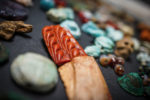 of wheat carved out of amber), bronze bracelets, bronze bells, faience and amethyst scarabs, human and animal figures, buttons and a skull carved out of bone.
of wheat carved out of amber), bronze bracelets, bronze bells, faience and amethyst scarabs, human and animal figures, buttons and a skull carved out of bone.
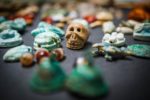 The contents mark the chest as more than a simple jewelry box, although there are numerous pieces of personal adornment that would have been worn by a woman like the amber beads and bronze bracelets. The figurines, scarabs, skulls, phalluses and other objects were protective amulets, figures and symbols with apotropaic value (ie, the power to ward off the evil eye, curses, etc.). Phalluses and
The contents mark the chest as more than a simple jewelry box, although there are numerous pieces of personal adornment that would have been worn by a woman like the amber beads and bronze bracelets. The figurines, scarabs, skulls, phalluses and other objects were protective amulets, figures and symbols with apotropaic value (ie, the power to ward off the evil eye, curses, etc.). Phalluses and 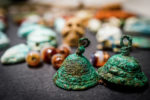 Harpocrates, the Greek syncretic version of Horus, son of Isis and Serapis, were common presences in Roman households as protectors of children and mothers. Wheat was a symbol of prosperity. The chiming of bells chased away bad luck. The closed fist, the skull, the scarabs were all good luck charms.
Harpocrates, the Greek syncretic version of Horus, son of Isis and Serapis, were common presences in Roman households as protectors of children and mothers. Wheat was a symbol of prosperity. The chiming of bells chased away bad luck. The closed fist, the skull, the scarabs were all good luck charms.
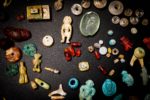 In this villa, archaeologists found the remains of 10 victims of Vesuvius’ fury, among them women and children. Researchers are attempting to establish the connection between the 10, whether they were related, with DNA analysis. It’s possible that the chest
In this villa, archaeologists found the remains of 10 victims of Vesuvius’ fury, among them women and children. Researchers are attempting to establish the connection between the 10, whether they were related, with DNA analysis. It’s possible that the chest 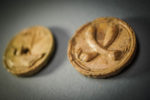 of treasures belonged to one of these women. It was unlikely to be the property of the lady of the house because there was no gold at all in the box, and a member of this wealthy family would certainly have owned gold pieces as it was de rigeur among the moneyed elites of Pompeii in 79 A.D.
of treasures belonged to one of these women. It was unlikely to be the property of the lady of the house because there was no gold at all in the box, and a member of this wealthy family would certainly have owned gold pieces as it was de rigeur among the moneyed elites of Pompeii in 79 A.D.
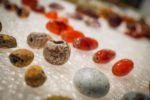 The artifacts have been conserved and will soon go on display in a new exhibition dedicated to the style and manufacture of jewels unearthed in Pompeii.
The artifacts have been conserved and will soon go on display in a new exhibition dedicated to the style and manufacture of jewels unearthed in Pompeii.
